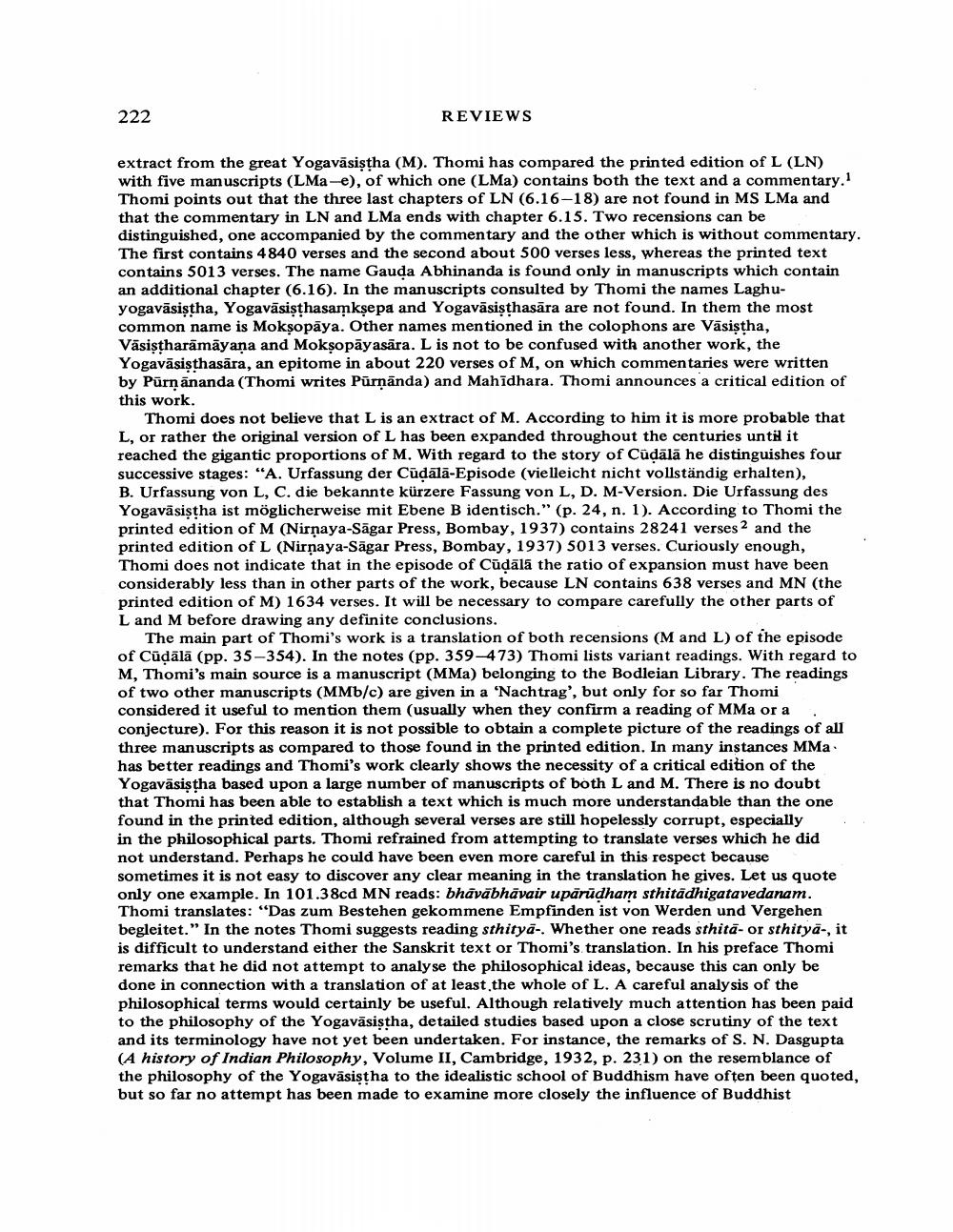Book Title: Book Reviews Author(s): J W De Jong Publisher: J W De Jong View full book textPage 4
________________ 222 REVIEWS extract from the great Yogavāsiştha (M). Thomi has compared the printed edition of L (LN) with five manuscripts (LMa-e), of which one (LMa) contains both the text and a commentary.1 Thomi points out that the three last chapters of LN (6.16-18) are not found in MS LMa and that the commentary in LN and LMa ends with chapter 6.15. Two recensions can be distinguished, one accompanied by the commentary and the other which is without commentary. The first contains 4840 verses and the second about 500 verses less, whereas the printed text contains 5013 verses. The name Gauda Abhinanda is found only in manuscripts which contain an additional chapter (6.16). In the manuscripts consulted by Thomi the names Laghuyogavāsiştha, Yogavāsişthasamksepa and Yogavāsisthasāra are not found. In them the most common name is Moksopāya. Other names mentioned in the colophons are Väsistha, Vāsiştharāmāyana and Moksopāyasāra. L is not to be confused with another work, the Yogavāsisthasāra, an epitome in about 220 verses of M, on which commentaries were written by Pūrnānanda (Thomi writes Pürņānda) and Mahīdhara. Thomi announces a critical edition of this work. Thomi does not believe that L is an extract of M. According to him it is more probable that L, or rather the original version of L has been expanded throughout the centuries until it reached the gigantic proportions of M. With regard to the story of Cūdālā he distinguishes four successive stages: "A. Urfassung der Cūdalā-Episode (vielleicht nicht vollständig erhalten), B. Urfassung von L, C. die bekannte kürzere Fassung von L, D. M-Version. Die Urfassung des Yogavāsiştha ist möglicherweise mit Ebene B identisch." (p. 24, n. 1). According to Thomi the printed edition of M (Nirnaya-Sāgar Press, Bombay, 1937) contains 28241 verses 2 and the printed edition of L (Nirnaya-Sāgar Press, Bombay, 1937) 5013 verses. Curiously enough, Thomi does not indicate that in the episode of Cūdālā the ratio of expansion must have been considerably less than in other parts of the work, because LN contains 638 verses and MN (the printed edition of M) 1634 verses. It will be necessary to compare carefully the other parts of L and M before drawing any definite conclusions. The main part of Thomi's work is a translation of both recensions (M and L) of the episode of Cūdālā (pp. 35-354). In the notes (pp. 359-473) Thomi lists variant readings. With regard to M, Thomi's main source is a manuscript (MM) belonging to the Bodleian Library. The readings of two other manuscripts (MMb/c) are given in a 'Nachtrag', but only for so far Thomi considered it useful to mention them (usually when they confirm a reading of MMa or a conjecture). For this reason it is not possible to obtain a complete picture of the readings of all three manuscripts as compared to those found in the printed edition. In many instances MMa. has better readings and Thomi's work clearly shows the necessity of a critical edition of the Yogavāsistha based upon a large number of manuscripts of both L and M. There is no doubt that Thomi has been able to establish a text which is much more understandable than the one found in the printed edition, although several verses are still hopelessly corrupt, especially in the philosophical parts. Thomi refrained from attempting to translate verses which he did not understand. Perhaps he could have been even more careful in this respect because sometimes it is not easy to discover any clear meaning in the translation he gives. Let us quote only one example. In 101.38cd MN reads: bhāvābhāvair upārūdham sthitādhigatavedanam. Thomi translates: "Das zum Bestehen gekommene Empfinden ist von Werden und Vergehen begleitet." In the notes Thomi suggests reading sthitya-. Whether one reads sthita- or sthitya-, it is difficult to understand either the Sanskrit text or Thomi's translation. In his preface Thomi remarks that he did not attempt to analyse the philosophical ideas, because this can only be done in connection with a translation of at least the whole of L. A careful analysis of the philosophical terms would certainly be useful. Although relatively much attention has been paid to the philosophy of the Yogavāsistha, detailed studies based upon a close scrutiny of the text and its terminology have not yet been undertaken. For instance, the remarks of S. N. Dasgupta (A history of Indian Philosophy, Volume II, Cambridge, 1932, p. 231) on the resemblance of the philosophy of the Yogavāsistha to the idealistic school of Buddhism have often been quoted, but so far no attempt has been made to examine more closely the influence of BuddhistPage Navigation
1 2 3 4 5 6 7 8 9 10 11 12 13 14 15 16 17 18 19 20 21 22 23 24 25 26
